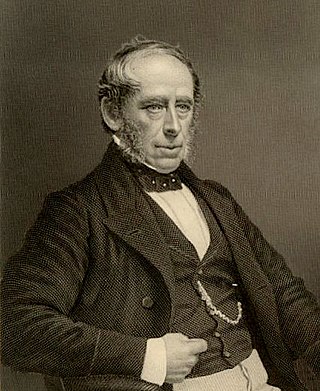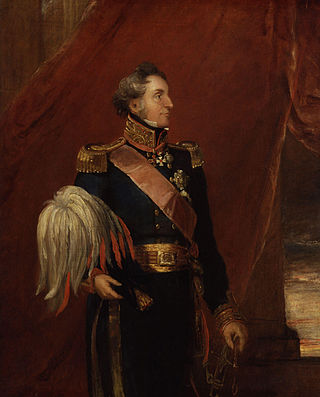
Earl of Chesterfield, in the County of Derby, was a title in the Peerage of England. It was created in 1628 for Philip Stanhope, 1st Baron Stanhope. He had been created Baron Stanhope, of Shelford in the County of Nottingham, in 1616, also in the Peerage of England. Stanhope's youngest son, the Hon. Alexander Stanhope, was the father of James Stanhope, 1st Earl Stanhope, while his half-brother Sir John Stanhope of Elvaston was the great-grandfather of William Stanhope, 1st Earl of Harrington.

Earl of Kingston is a title in the Peerage of Ireland. It was created in 1768 for Edward King, 1st Viscount Kingston. The Earl holds the subsidiary titles Baron Kingston, of Rockingham in the County of Roscommon, Viscount Kingston, of Kingsborough in the County of Sligo, Baron Erris, of Boyle in the County of Roscommon, and Viscount Lorton, of Boyle in the County of Roscommon, also in the Peerage of Ireland. He is also a baronet in the Baronetage of Ireland. Between 1821 and 1869 the earls also held the title Baron Kingston, of Mitchelstown in the County of Cork, in the Peerage of the United Kingdom.

Earl of Lonsdale is a title that has been created twice in British history, firstly in the Peerage of Great Britain in 1784, and then in the Peerage of the United Kingdom in 1807, both times for members of the Lowther family.

Earl of Mornington is a title in the Peerage of Ireland. It was created in 1760 for the Anglo-Irish politician and composer Garret Wellesley, 2nd Baron Mornington. On the death of the fifth earl in 1863, it passed to the Duke of Wellington; since that date, the title has generally been used by courtesy for the heir apparent to the heir apparent to the dukedom.

Earl Howe is a title that has been created twice in British history, for members of the Howe and Curzon-Howe family respectively. The first creation, in the Peerage of Great Britain, was in 1788 for Richard Howe, 4th Viscount Howe, but it became extinct upon his death in 1799. The second creation, in the Peerage of the United Kingdom, was in 1821 for Richard Curzon-Howe, 2nd Viscount Curzon, and it remains extant.

Baron Hampton, of Hampton Lovett and of Westwood in the County of Worcester, is a title in the Peerage of the United Kingdom. It was created in 1874 for the Conservative politician Sir John Pakington, 1st Baronet.

Baron Glenconner, of The Glen in the County of Peebles, is a title in the Peerage of the United Kingdom. It was created in 1911 for Sir Edward Tennant, 2nd Baronet, who had earlier represented Salisbury in the House of Commons as a Liberal and also served as Lord Lieutenant of Peeblesshire. Lord Glenconner was succeeded by his second son, the second baron. The latter was succeeded in 1983 by his eldest son, the third baron, who bought the island of Mustique. As of 2014, the titles are held by the third baron's grandson, the fourth baron, who became the next-to-youngest peer in the realm when he succeeded in August 2010.
Baron Swaythling, of Swaythling in the County of Southampton, is a title in the Peerage of the United Kingdom. It was created in 1907 for the British Jewish Liberal politician, banker and philanthropist, Sir Samuel Montagu, 1st Baronet. He had already been created a Baronet, of South Stoneham House in the County of Southampton and of Kensington Palace Gardens in the County of London, in 1894. As of 2010, the titles are held by his great-great-grandson, the fifth Baron, who succeeded his father in 1998.

Henry Hussey Vivian, 1st Baron Swansea, known between May 1882 and June 1893 as Sir Hussey Vivian, 1st Baronet, was a Welsh industrialist and politician from the Vivian family.
Baron Vivian, of Glynn and of Truro in the County of Cornwall, is a title in the Peerage of the United Kingdom and held by a branch of the Vivian family. It was created on 19 August 1841 for the soldier Sir Hussey Vivian, 1st Baronet. He had already been created a baronet, of Truro in the County of Cornwall, on 19 January 1828. His eldest legitimate son, the second Baron, represented Bodmin in the House of Commons and served as Lord Lieutenant of Cornwall. His son, the third Baron, served as British Ambassador to Italy from 1891 to 1893. The latter's great-grandson, the sixth Baron, was a soldier and a Conservative member of the House of Lords. Lord Vivian was one of the ninety elected hereditary peers that were allowed to remain in the House of Lords after the passing of the House of Lords Act 1999. As of 2014 the titles are held by his only son, the seventh Baron, who succeeded in 2004.

Baron Cottesloe, of Swanbourne and Hardwick in the County of Buckingham, is a title in the Peerage of the United Kingdom. It was created on 2 March 1874 for the Conservative politician and former Chief Secretary for Ireland, Sir Thomas Fremantle, 1st Baronet (1798–1890). He was the son of Admiral Sir Thomas Fremantle (1765–1819). Lord Cottesloe had already been created a Baronet, of Swanbourne in the County of Buckingham, on 14 August 1821, chiefly in recognition of his father's services, and with remainder to the latter's heirs. His father Sir Thomas Fremantle was created Baron Fremantle, of the Austrian Empire, which Lord Cottesloe inherited in 1819 with the death of his father. Subsequently, in 1822 he was given a Royal licence, which authorized him and his successors to use the title in Britain. However, a warrant issued on 27 April 1932 withdrew all the royal licences, only allowing the use of the title to the then current holders, their heir and their heir's heir. The fifth baron was the last holder being allowed to use the Austrian title in the United Kingdom.

Lieutenant General Richard Hussey Vivian, 1st Baron Vivian, known as Sir Hussey Vivian from 1815 to 1828 and Sir Hussey Vivian, Bt, from 1828 to 1841, was a British cavalry leader from the Vivian family.

Richard Glynn Vivian was a British art collector and philanthropist from the Vivian family, and the founder of the Glynn Vivian Art Gallery in Swansea.

John Henry Vivian FRS was a Welsh industrialist and politician of Cornish extraction. He was a member of the Vivian family.

There have been nine baronetcies created for persons with the surname Cooper, one in the Baronetage of England, one in the Baronetage of Ireland and seven in the Baronetage of the United Kingdom.
There have been two baronetcies created for members of the Vivian family, both in the Baronetage of the United Kingdom. Sir Hussey Vivian, created Baronet in 1828, was the uncle of Sir Henry Vivian, created Baronet in 1882. Both were later elevated to the peerage.
Sir Arthur Pendarves Vivian was a British industrialist, mine-owner and Liberal politician from the Vivian family, who worked in South Wales and Cornwall, and sat in the House of Commons from 1868 to 1885.

Odo Richard Vivian, 3rd Baron Swansea, MVO, DSO, TD, was a Welsh soldier from the Vivian family.
Vivian is the name of a British noble family of Cornish extraction that rose to wealth in various regions of the British Isles. Over time, several members of the Vivian family were made knights, baronets and peers. Hereditary titles held by the family include the Vivian barony as well as the Swansea barony. Several other members of the family have also risen to prominence.
John Vivian was a British industrialist. Himself a descendant of the Vivians of Trewan, Cornwall, he was the first member of this branch of the family to settle in South Wales, where he became the ancestor of the Vivian baronets and barons. He was the son of Reverend Thomas Vivian and Mary Hussey, of Truro St. Mary, Cornwall, who had been married on 30 November 1747 at Kenwyn, Cornwall.
















